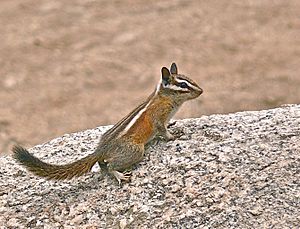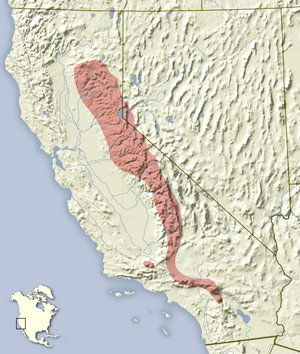Lodgepole chipmunk facts for kids
Quick facts for kids Lodgepole chipmunk |
|
|---|---|
 |
|
| Conservation status | |
| Scientific classification | |
| Genus: |
Neotamias
|
| Species: |
speciosus
|
| Synonyms | |
|
Tamias speciosus Merriam, 1890 |
|
The Lodgepole chipmunk (Neotamias speciosus) is a small, quick rodent that belongs to the squirrel family. You can find these chipmunks in the U.S. state of California. They live high up in the mountains, usually between 1,500 and 3,000 meters (about 4,900 to 9,800 feet) above sea level. People sometimes call them by other names, like the Tahoe chipmunk, Sequoia chipmunk, Mt. Pinos chipmunk, or San Bernardino chipmunk.
Contents
What Does a Lodgepole Chipmunk Look Like?
Female Lodgepole chipmunks are usually a bit bigger than the males. Females weigh about 55 to 69 grams, while males are a bit lighter, around 50 to 60 grams. Their bodies are also different in length. Females measure about 197 to 229 millimeters (7.75 to 9 inches) long. Males are usually between 200 and 222 millimeters (7.8 to 8.7 inches).
Both male and female chipmunks have similar fur patterns. They have white stripes on their backs and faces. The stripes down the middle of their back are often a yellowish-white color. The stripes on their sides are brighter white. This chipmunk species has darker and wider stripes on its face compared to its relatives.
Other cool markings include dark black stripes on their backs. They don't have a black stripe under their main white side stripe. Their sides are a bright orange color, and their shoulders are orange-gray. Their belly is gray, and their rump (backside) is also gray. The top of their head is brown with some gray mixed in. Their tail is longer in females, about 13 to 22 millimeters (0.5 to 0.87 inches) long. It has a black tip and a cinnamon-colored body.
Where Do Lodgepole Chipmunks Live?
The Lodgepole chipmunk lives in the high mountains of California. You can find them in the Sierra Nevada, San Jacinto, San Bernardino, and San Gabriel Mountain ranges. Their home also stretches into the Lake Tahoe area, which is in the western part of Nevada.
These chipmunks prefer to live in subalpine forests. These are forests found at high elevations, just below the treeline. These forests are mostly made up of different types of pine trees, like Lodgepole, Jeffrey, Ponderosa, and Sugar pines. They also live among fir trees, such as Douglas, white, and red firs. You might spot them looking for food around and on top of rocks and fallen logs on the forest floor.
Scientists have studied how different chipmunk species share their mountain homes. In 1978, a scientist named Mark A. Chappell did an experiment. He noticed that four different chipmunk species, including the Lodgepole chipmunk, lived in separate areas of the Sierra Nevada mountains. This means their living spaces didn't overlap.
Each species, like the Alpine chipmunk, the Lodgepole chipmunk, the Yellow-pine chipmunk, and the Least chipmunk, lived at different heights in the mountains. The Lodgepole chipmunk usually lived between 2,400 and 3,000 meters (about 7,900 to 9,800 feet) high. This area is called the lodgepole pine zone. It's located between the very high alpine zone and the lower pine/mountain mahogany zone. This shows that each chipmunk species has a special zone where it feels most comfortable.
Scientists also looked at how forest management, like controlled burning and thinning trees, affected these chipmunks. From 1999 to 2003, they studied chipmunks in the southern Sierra Nevada Mountains. They found that these forest practices didn't greatly change the number of chipmunks right away. However, they did notice that the chipmunks' body weight decreased. This was likely because changes in the forest structure made it harder for them to find enough food, especially tree cones.
Who Are Their Predators?
Lodgepole chipmunks have several natural enemies that hunt them. These include coyotes, foxes (especially the gray fox), and hawks like the Cooper's hawk and red-tailed hawk. Other predators are bobcats and martens.
To stay safe, Lodgepole chipmunks are very good at climbing trees. This helps them escape quickly when a predator is near. They also use their fur colors and patterns to blend in with their surroundings. This natural camouflage makes it harder for predators to spot them in the forest.
Behavior and Communication
Lodgepole chipmunks use different sounds and actions to communicate. They make special noises during courtship, which is when they try to find a mate. They also make sounds when they are scared by a predator.
During courtship, both males and females might flip their tails or show certain body poses. These are visual signals to each other. They also use "chips" and "whistles" to communicate during this time.
When a chipmunk is frightened or wants to warn others, it makes specific sounds. These include a high-pitched "whisk" and a shrill "tsew." They can also make a fast, repeated series of sounds like "pst-pst-pst-a-ku."
Lodgepole chipmunks spend the spring and summer gathering and storing food. This is called caching. They hide food in different spots to prepare for winter. They begin their hibernation at the end of October. They stay asleep until early to mid-April, which is about five to six months.
What Do Lodgepole Chipmunks Eat?
The Lodgepole chipmunk is an omnivore, meaning it eats both plants and animals. Their diet includes small mammals, birds, and bird eggs. They also eat small invertebrates like arthropods and insects.
For plant matter, they eat leaves, flowers, pollen, fungi, and seeds. Like many rodents, they gather and store food. This helps them survive the long winter hibernation when food is scarce.
These chipmunks play an important role in the forest. When they eat seeds, some seeds might not be fully digested. These seeds are then spread around the habitat when the chipmunk goes to the bathroom. This helps new plants grow.
They also help spread a special kind of fungi called ectomycorrhizal fungi. This fungi is very important for trees. It helps trees get more water and nutrients from the soil. By spreading spores, seeds, and pollen, Lodgepole chipmunks help keep the forest and mountain ecosystems healthy.
Lodgepole Chipmunk Life Cycle and Reproduction
Lodgepole chipmunks use both visual displays and vocalizations to find a mate. They usually breed once a year, from May to early June. After about a one-month pregnancy, three to six young chipmunks, called pups, are born in early June.
The mother chipmunk provides milk for her pups for about one month. This helps the young, who are not very developed when they are born, grow strong. By the fall, the young chipmunks are independent and can take care of themselves. They become old enough to have their own babies the following spring.
It is believed that Lodgepole chipmunks have a mating system where one male mates with several females. The father chipmunk does not help raise the young. All the parental care is provided by the mother.
See also
 In Spanish: Neotamias speciosus para niños
In Spanish: Neotamias speciosus para niños



